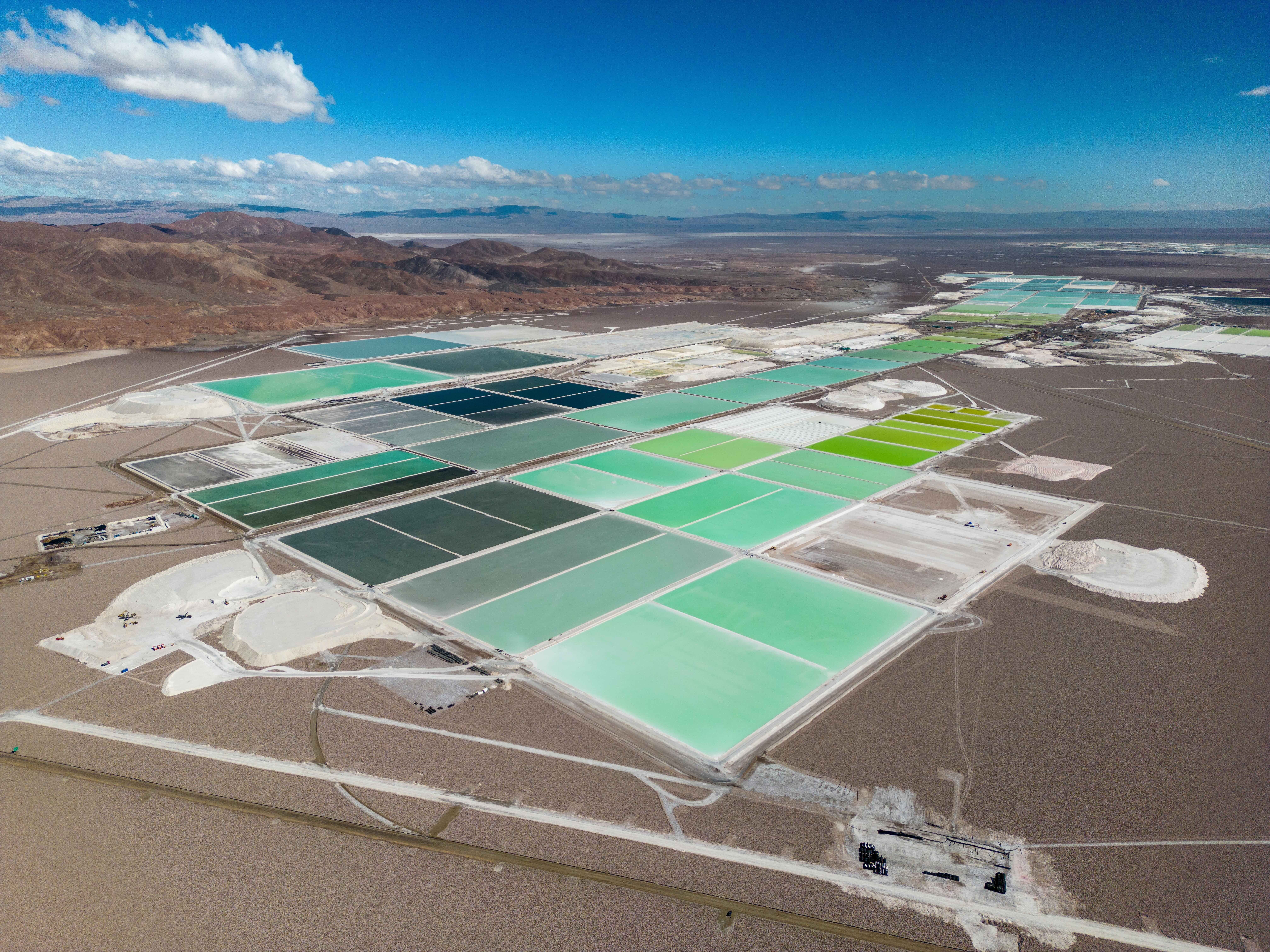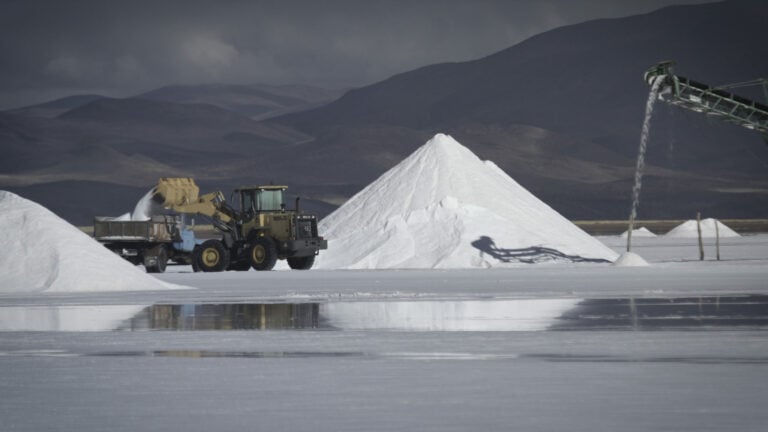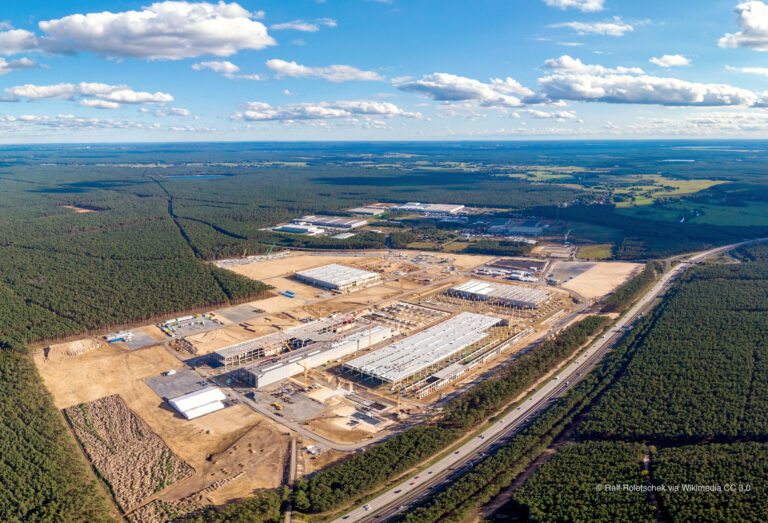
The EU’s critical minerals crusade
How the EU trade policy on raw materials deepens the environmental and inequality crises


Summary
- The EU is in a global scramble for critical minerals to support its industries in profiting from the energy transition.
- To ensure unhindered access to minerals, the EU is ramping up trade agreements and partnerships with resource-rich countries.
- As long as the EU fails to address its overconsumption of resources, the EU trade strategy will reinforce unequal trade relations and intensify resource extractivism.
In its efforts to realise its energy transition and become ‘climate-neutral’, the European Union has joined the global scramble for raw materials with a neocolonial slant. Instead of addressing its own overconsumption, Europe is fuelling its demand for nickel, lithium, and other transition minerals by exploiting unequal trade agreements with resource-rich countries in the Global South.
The European Commission has laid out an ambitious strategy to achieve ‘climate neutrality’ by 2050. Much of its effort is directed to the electrification of mobility. In the first instalment of our series on the battery value chain(opens in new window) , we demonstrated the sheer amount of raw materials needed to produce batteries for electric vehicles (EVs). To satisfy its appetite for nickel, lithium, and other transition minerals, the European Union has geared up its trade arrangements with resource-rich countries in the Global South. It has also set in motion various initiatives to facilitate the transition, of which the most important are the Green Deal Industrial Plan(opens in new window) , the Net-Zero Industry Act(opens in new window) , and the Critical Raw Materials Act(opens in new window) .
Despite the green tint, Europe is ultimately pursuing a resource-intensive growth strategy to bolster its industries in profiting from low-emission technologies. This prioritisation of growth neglects that affluent countries’ overconsumption of resources is the root cause of climate change and the major driver of biodiversity loss, pollution, and waste.
Rather than reducing unsustainable resource consumption, the EU seeks to ramp up and diversify its supplies by partnering with resource-rich countries under strategic partnerships and trade agreements. EU member states and other high-income countries already use six times more(opens in new window) materials per capita than low-income countries. Through global trade, the EU displaces the environmental impacts of its resource consumption – such as pollution, water scarcity, and CO2 emissions – to resource-rich countries, often with in these regions. Worse, the unfavourable trade regime can prevent resource-rich countries from climbing up global value chains.
While it is crucial to phase out oil and decarbonise mobility and transport, the current focus on mass-producing EVs for individual private use is not sustainable. There are alternative, less resource-intensive ways to meet our mobility needs, such as improved urban planning, enhanced public transport, and the promotion of active modes of travel like biking and walking. According to the UN International Resource Panel, adopting these measures could potentially halve the world’s resource and energy consumption by 2060 and reduce emissions by 60 per cent, offering a hopeful path towards a more sustainable future.
This piece unveils how the EU weaponises its trade policy to secure and diversify access to critical minerals to sustain its green transition, and how that affects mineral governance and value retention in resource-rich countries. How can the EU’s raw materials trade strategy respect the policy space of resource-rich countries to benefit from their mineral wealth in a more sustainable way? And, importantly, how can the EU reduce its unsustainable consumption of resources?
The EU’s global dependency on raw materials
Raw materials are foundational for the EU’s strategic sectors of renewable energy, e-mobility, energy-intensive industry, ICT, and aerospace and defence. However, the EU currently produces only 2 per cent of the raw materials required for its wind turbines, Li-ion batteries, traction motors, and heat pumps. The EU sources the majority of these materials from other regions. For its solar panels, space launchers, robotics, drones, and satellites, the EU contributes no more than 4 per cent of the raw materials.
Electric vehicles account for the majority (50 to 60 per cent) of projected material demand from all low-carbon technologies, so most of the minerals end up in the batteries of privately owned electric cars, not in wind turbines or solar panels.
A handful of countries dominate(opens in new window)
the production of such materials, notably the Democratic Republic of Congo (cobalt), Australia (lithium), Chile (copper and lithium), China (graphite), and Indonesia (nickel). China is the most dominant country in processing minerals, with a 100 per cent share of the global refined supply of natural graphite, over 90 per cent of manganese, 70 per cent of cobalt, almost 60 per cent of lithium, and roughly 40 per cent of copper.
The EU’s strategic industries are, therefore, highly dependent on these countries. An EU foresight report(opens in new window)
(2023) assessed EU dependencies in the supply chains of 15 key technologies. The report found that supply risks are highest at the raw materials stage, where the EU share in global production is never more than 7 per cent. The EU’s vulnerability tends to decrease along the value chain. But for several technologies, such as Li-ion batteries, the EU remains highly dependent throughout the entire supply chain. With an average 28 per cent share of global production, the EU is relatively stronger at the stage of manufacturing final technologies.
What does the EU’s scramble for critical minerals look like?
The EU’s use of trade to secure access to raw materials is not new. Since colonial times, Europe has built wealth by importing cheap raw materials and exporting high-value finished products. Such trade relations have become the basis for many structural economic deficiencies(opens in new window)
in the global economy, with many countries in the Global South remaining locked at the bottom of the global value chain due to their excessive reliance on extractive industries and low-value-added manufacturing.
The EU’s renewed focus(opens in new window)
on domestic ‘green’ growth and consequent pursuit of critical raw materials in the context of the ‘green’ transition perpetuate existing dynamics of dependency and unequal development.
In response to China’s Made in China 2025 programme and the United States’ Inflation Reduction Act, both of which involve major state support for domestic industries, the EU has strengthened its own plans to decarbonise and revitalise European industries through a package of legislative acts.
Through its Green Deal Industrial Plan, the EU seeks to mobilise the necessary funds to “enhance the competitiveness of Europe’s net-zero industry” and “seize the net-zero opportunity” expected to be worth USD 650 billion per year by 2030. Under the proposed Net-Zero Industry Act, the EU aims by 2030 to produce 40 per cent of its strategic net-zero technologies, including batteries. And the EU’s Critical Raw Materials Act (CRMA) sets out the goals to extract at least 10 per cent, process 40 per cent, and recycle 25 per cent of its annual consumption of strategic minerals by 2030. No more than 65 per cent of each strategic raw mineral should come from a single third country.
SOMO and many civil society organisations(opens in new window)
have raised concerns about the CRMA, which allows the EU to identify strategic mining, processing, or recycling projects and grant them regulatory exemptions, compromising environmental safeguards. The prioritisation of fast permitting for such projects poses a significant risk of overlooking social and environmental impacts. In theory, the EU requires companies to carry out projects sustainably. However, companies are allowed to show compliance with the sustainability criterion by obtaining certification from deeply flawed industry schemes with structural deficiencies such as conflicts of interest and lack of transparency and accountability.
In sum, the CRMA and the other EU initiatives mentioned above fail to address Europe’s unsustainable consumption.
To diversify the supply of raw materials, the CRMA outlines a series of actions related to international trade, including the creation of a Critical Raw Materials Club
, expanding strategic partnerships, and using trade agreements to secure access.
Over the past three years, the EU has signed strategic partnerships on raw materials(opens in new window)
with a number of emerging and developing economies. These partnerships are presented as ‘mutually beneficial’, focusing on sustainable and responsible production and sourcing of critical raw materials, and promoting local ‘value addition’ in these countries. But the texts are ambiguous, lacking clear definitions for these and other terms. They also neglect asymmetric international relationships and do not properly address partners’ own transitions to renewable energy and enhancement of local access to clean energy. Importantly, the strategic partnerships are not binding instruments, and their vague ‘win-win’ language is often undermined by the binding provisions of free trade agreements (FTAs).

How EU trade policy on raw materials deepens inequality
According to the International Renewable Energy Agency(opens in new window) , mining of nickel, lithium, and cobalt accounts for only 0.6 per cent of the total value of the battery and electric vehicle value chain. This increases only to 1.1 per cent when the smelting and refining of mineral concentrates into industry-grade metals are considered. The biggest value is at the other end of the chain, in battery and EV production.
Many countries have increased their control over mineral resources to improve their position in the value chain. Export restrictions on critical minerals are on the rise(opens in new window)
, affecting accessibility and prices for consuming regions such as the EU. For example Indonesia(opens in new window)
, Namibia(opens in new window)
, and Zimbabwe(opens in new window)
have taken measures to discourage exports of raw materials and promote domestic processing instead, in an attempt to build higher-value-adding domestic downstream industries.
In response, the EU has updated(opens in new window)
its trade strategy with a focus on ‘open and strategic autonomy’. This strategy calls for stricter enforcement measures, utilising World Trade Organization (WTO) rules, FTAs, and unilateral trade defence, to protect EU industries’ access to raw materials.
Use of WTO rules
The EU remains a staunch defender of the WTO as a forum for battling measures resource-rich countries take to restrict the export of unprocessed materials.
In 2012, the EU successfully challenged China’s export restrictions on rare earth minerals, pushing China to remove the restrictions in 2015.
In 2021, the EU filed a complaint to challenge Indonesia’s export ban on nickel ore and other raw materials, contending these measures restrict access and distort global market prices affecting EU steelmakers. In 2022, the WTO dispute panel ruled(opens in new window)
in favour of the EU and rejected Indonesia’s defence that the measures were to prevent critical shortages of a product essential to the Indonesian economy. Indonesia subsequently appealed(opens in new window)
against the decision, but the process is stalled due to the non-functioning of the WTO’s Appellate Body. This situation allows Indonesia to ignore the panel’s decision.
Although the WTO generally prohibits measures that quantitatively restrict exports, such as quotas, licensing procedures, and export bans, many governments still use other measures like export taxes. The EU attempts to stop other governments from implementing such measures by including this prohibition in FTAs and other bilateral agreements.
Read about Indonesia's nickel industrial policies
Since 2016, the EU has been negotiating with Indonesia on a bilateral FTA. Through the proposed agreement, the EU seeks to further target Indonesia’s measures aimed at promoting value-adding downstream industries in the mineral sector.
Indonesia has the world’s largest nickel reserves and in 2023 produced half of global supply. In 2014, it imposed export restrictions(opens in new window) on raw materials, including nickel ore, to promote job creation and economic development. Foreign-owned mining firms had to gradually transfer majority ownership to the state-owned company MIND ID and construct smelters to obtain export permits. The ban was temporarily lifted in 2016 due to budget deficits but resumed in 2020.
Before the export ban, Indonesia had only two nickel smelters. By 2020, there were 13, and there are expected to be 30 by 2024. In the last decade, the country has attracted over USD 15 billion in foreign direct investment in nickel processing, largely from China’s Tsingshan Holding Group. Nickel-related exports from Indonesia surged more than tenfold between 2013 and 2022, mainly attributed(opens in new window) to increased value addition from smelting and higher export volumes.
The Indonesian government aims to climb up the nickel value chain(opens in new window) , with a long-term goal of establishing a complete EV supply chain, including producing cathodes, battery cells, and EVs. Foreign EV battery companies investing in Indonesia must partner with the government-established Indonesia Battery Corporation to transfer technology and create jobs.
Fiscal incentives and tax holidays promote investment in the EV sector, with local content(opens in new window) requirements set to rise from 40 per cent in 2023 to 80 per cent by 2030. Notable foreign investments include those of LG Energy Solution (USD 9 billion), CATL (USD 6 billion), and Mitsubishi. In 2022, Hyundai Motor Company manufactured Indonesia’s first locally produced EV(opens in new window) .
Indonesia’s nickel strategy has caused some negative consequences. The export ban on nickel ore created a nickel oligopsony(opens in new window) benefiting a small number of buyers with smelting capacity with the supply of cheap nickel. Mining companies are now extracting more nickel, which has created jobs but also resulted in serious social and environmental costs. On the positive side, the expansion of nickel processing has brought advanced technology and economic processes to Indonesia.
Following these experiences, Indonesia is considering extending its policies to bauxite ore, on which it has imposed an export ban(opens in new window) since June 2023. Additionally, the country is considering similar measures for copper, tin, and palm oil.
However, the FTA the EU proposes may complicate Indonesia’s further roll-out of such downstream measures and industrial policies. The EU stance on export restrictions remains a thorny issue, making it unlikely the parties will conclude negotiations any time soon. At the same time, the FTA may also restrict Indonesia’s capacity to deploy requirements on joint ventures, local content use, and transfer of technology to generate positive spillover effects from foreign direct investment.
Further trade liberalisation may expose Indonesia’s industries to increased foreign competition, which could undermine its ambitions to develop domestic EV industries. According to the EU’s own impact assessment(opens in new window) , the EU–Indonesia trade agreement may cause a 1.7 per cent decline in Indonesia’s automotive output, decrease the sector’s value by EUR 545 million, and reduce employment by 2 per cent.
EU expansion of FTAs
The EU is positioning itself as the most active economic bloc in negotiating and modernising FTAs, continuously expanding its network of such agreements.
While each FTA’s content results from negotiations, they often include common elements that impact governments’ regulatory capacities. Such elements affect other governments’ ability to manage their mineral resources or to introduce measures that ensure greater financial benefits stay within their territories.
Among the most detrimental aspects of EU FTAs are:
1) Reducing or eliminating import tariffs. This could hinder the development of domestic industries, which will struggle to compete with increased foreign imports, such as infant industries in the renewable energy or mobility sectors. Loss of tariff revenues could also impact(opens in new window)
total fiscal revenues and increase government debt.
2) Prohibiting export duties or any other type of export restriction, such as export bans or quotas, domestic processing requirements, marketing obligations, or licensing requirements. These prohibitions could harm the ability of other countries to effectively monitor or control mineral export activities(opens in new window)
, generate revenues, ensure domestic supply security, promote further processing and value addition, and protect downstream industries.
3) Requiring market access and liberalisation commitments. Such provisions would prevent(opens in new window)
other countries from limiting or putting conditions on incoming investments. They would prohibit governments from: controlling the number of companies engaging in a specific economic activity (e.g. mining or EV battery production); setting limitations on total operations or total quantity of output; limiting foreign capital participation in a business to minority shareholdings (which would allow a country to ensure domestic actors can grow); or requiring foreign investors to establish joint ventures with domestic, state-owned companies.
4) Prohibiting performance requirements. This would prevent countries from requiring that foreign investors use specific levels or percentages of domestic inputs, transfer technology, hire local workers, or conduct research and development within the country. These provisions would further constrain(opens in new window)
trading partners’ capacity to enhance and upgrade domestic industrial capacities through the spillover effects and linkages associated with foreign direct investment.
5) Including rules on investment protection. These rules would enable EU investors to directly sue other governments through the Investment Court System for various regulatory measures affecting their business activities and expected profits. This legal mechanism grants European investors significant leverage to challenge(opens in new window)
other countries’ laws and regulations, including legislative provisions on subsidies, tax breaks, royalty rates, environmental standards, and permit revocations, and moratoria on new permits.
6) Integrating energy and raw materials chapters into FTA negotiations that go beyond current WTO rules against export barriers for energy and raw materials. These chapters aim to ensure free market principles in relation to trade in energy and raw materials, including by prohibiting export monopolies and dual price schemes (where prices for domestic sales are lower than for exports), and ensuring EU access to energy transport infrastructure and licensing procedures. Such provisions could prevent(opens in new window)
government agencies and state-owned companies from managing the supply of raw materials in the national interest, whereas free access to energy infrastructure could disrupt domestic energy supplies.
Read about Chile's National Lithium Strategy
Chile's National Lithium Strategy

In December 2023, the EU and Chile signed a new trade agreement that will ensure greater EU access to raw materials and renewable fuels, such as lithium, copper, and hydrogen. The EU currently sources(opens in new window) 79 per cent of its lithium supply from Chile, which holds(opens in new window) the world’s largest reserves and is the second largest producer.
Chile’s constitution stipulates that the exploitation of lithium can be carried out only by the state or state-owned companies or through lease agreements. At present, only SQM and Albemarle have agreements to lease lithium reserves in Chile. These agreements expire in 2030 and 2043 respectively. Twenty-five per cent of the country’s lithium production is reserved for preferential sale to companies supporting higher-value-added domestic projects.
In June 2023, President Gabriel Boric presented a new National Lithium Strategy(opens in new window) , which aims to expand lithium production and value addition in Chile through increased state participation. A new national lithium company will coordinate public-private partnerships to boost production and attract investments, respecting existing lease agreements.
The new strategy aims to promote downstream activities in Chile’s battery value chain, with companies like BYD planning(opens in new window) to invest in a USD 290 million lithium cathode factory after receiving preferential prices for lithium carbonate from the Chilean economic development agency, CORFO, in April 2023.
In December 2023, state-owned Codelco and SQM agreed on the first public-private joint venture in the lithium sector. By 2025, Codelco will hold majority ownership of the Salar de Atacama mine, while SQM retains operational authority. This agreement enables an expansion of lithium production and extends operations until 2060, with Codelco assuming operational control in 2030.
However, the EU–Chile trade agreement may hamper Chile’s abilities to support domestic industries and to further climb up the value chain. Increased state control over the lithium sector and efforts to promote local value addition may conflict with the FTA market access and liberalisation provisions.
Under the FTA’s energy and raw materials chapter, Chile may offer preferential prices to domestic industrial sectors to promote value addition, but such measures must not restrict exports or disadvantage EU sourcing. Any preferential pricing for companies from other countries must be extended “immediately and unconditionally” to EU companies, and preferential prices shall not be below the lowest price for exports during the preceding year. This means that prices still have to be regularly aligned to international market prices, which effectively restricts Chile’s dual pricing scheme to incentivise local or other preferred buyers of its lithium.
Unilateral trade defence practices
In addition to FTAs, the EU has bolstered its unilateral trade defence instruments(opens in new window)
“to arm-twist other countries into agreeing to supply European factories with raw materials”. For example, the EU may impose higher import tariffs on countries that aim to process raw materials domestically.
In the aforementioned dispute with Indonesia over nickel export restrictions, the European Commission is preparing to use the EU Enforcement Regulation(opens in new window)
for the first time. This would empower the EU to unilaterally enforce the WTO decision despite the absence of a functional WTO Appellate Body. This action may lead to retaliatory tariffs on Indonesian goods or quantitative restrictions on imports and exports.
In response to complaints from the European Steel Association, the EU has already imposed anti-dumping duties on stainless-steel imports from Indonesia, which Indonesia is currently challenging before the WTO.
Green mercantilism and policy weaponisation
In sum, the EU’s trade and industry strategy can be described as a variant of ‘green mercantilism’: promoting substantial investment in key domestic industries and technologies to bolster economic competitiveness, while also accumulating wealth through trade surpluses in worldwide markets for low-carbon technologies and services.
The EU energy and mobility transitions foster global inequality. Under current pathways, China, the EU, and the US are set to hold almost 80 per cent of the market share for clean energy technology by 2030. To produce such technologies, these affluent world powers import raw materials whose extraction causes serious social and environmental impacts in resource-rich countries, while the producer countries obtain little value added from the use of their metals and minerals. By prioritising the economic ambitions of its industries, which rely on the exploitation of resources in other regions, EU trade policy sustains neocolonial and asymmetric international relations.
The economic system the EU perpetuates thus relegates countries in the Global South to mere sources of raw materials. The EU’s weaponisation of trade policy as a tool of coercion clearly undermines these countries’ ability to manage their own resources and support their industries.
The EU uses the narrative of ‘win-win’ partnerships to exploit the natural resources of other countries for its own economic benefit. This approach not only is unjust; it also maintains the resource-intensive growth model that lies at the root of the planetary crises.
Increasing resource extraction deepens environmental crises
Intensifying geopolitical competition over decarbonisation is driving up demand for critical raw materials for electric vehicles and other low-carbon technologies. This race for resources, primarily driven by the EU, the US, and China, has profound impacts on people and ecosystems worldwide.
For example, the rapid growth of nickel mining in Indonesia has led to severe consequences(opens in new window) including deforestation, biodiversity loss, pollution, land erosion, and coastal area destruction. Local and Indigenous communities affected by mining face increased threats. In Chile, lithium extraction in the Atacama region threatens(opens in new window) fragile ecosystems and water resources, leaving behind waste salts and toxic chemicals that harm local freshwater stores and iconic flora and fauna (such as endemic flamingo species), often without proper consultation with Indigenous communities.
EU FTAs are designed to facilitate trade and investment in energy and raw materials, with increased activity in extractive industries a main objective. The EU’s impact assessments(opens in new window) on trade and sustainability frequently acknowledge the significant social and environmental consequences of resource extraction. These assessments also warn that EU FTAs could exacerbate these negative impacts due to the anticipated rise in demand for raw materials, as well as the EU’s investments in these sectors.
Although EU FTAs include trade and sustainable development (TSD) chapters, these provisions are too weak and ineffective to meaningfully address the negative social and ecological impacts of raw materials extraction. TSD chapters merely reaffirm commitments to international labour and environmental conventions without addressing the need for effective respect for the rights of mining-affected communities, including Indigenous Peoples’ right to free, prior and informed consent (FPIC). Except for under the EU–New Zealand FTA, disputes under these provisions are handled through dialogue mechanisms without the possibility of sanctions, hindering effective enforcement.
As EU FTAs set out to increase trade and investment in critical raw materials, driving and exacerbating the abuse of nature and people, they fail to guarantee compliance with international norms and provide insufficient access to remedies for affected communities.
The way forward: aligning EU trade policy with a just transition
The science is clear. Phasing out the fossil-fuel-based economy is not enough to halt multiple planetary crises. Global resource extraction and processing(opens in new window)
are already responsible for 60 per cent of climate change impacts, 40 per cent of air pollution, and 90 per cent of water stress and land-related biodiversity loss. Affluent countries urgently need to reduce their resource use. The EU is currently doing the opposite by aggressively scrambling to control minerals to feed European companies’ ambitions to profit from the market for low-carbon technologies.
Most of the scrambled-for minerals are not for producing essential low-carbon technologies such as wind and solar power but rather to supply the manufacture of batteries for a mobility sector underpinned by privately owned electric vehicles. Demand for batteries for e-mobility represents over 90 per cent of the EU’s strategic demand for nickel, cobalt, graphite, and lithium.
For the EU to reduce its pressure on other regions and planetary boundaries, it has to reduce its unsustainable consumption of resources, including critical minerals.
EU policymakers should set a clear, binding reduction target to decrease the bloc’s material footprint, which is currently more than double a sustainable level(opens in new window)
. An EU directive on Sustainable Resource Management(opens in new window)
, advocated by leading European environmental organisations, could introduce such a legally binding target for resource consumption reduction.
In addition, sector-specific targets should be introduced, importantly for mobility. Strategies to decarbonise the mobility sector should be aligned with resource reduction targets, beginning with the production of fewer and smaller batteries(opens in new window)
and EVs, which can significantly reduce mineral demand.
Where the EU remains reliant on imports of raw materials, it should ensure its sourcing adheres to the highest social and environmental standards, including the full protection of, and respect for, human rights, encompassing Indigenous people’s right to FPIC, and strong environmental governance. Strict regulations on responsible sourcing and robust oversight are crucial to ensure adherence to human rights and environmental standards throughout supply chains.
Large companies that use such raw materials in their value chain are increasingly being required(opens in new window)
to conduct mandatory human rights and environmental due diligence to identify and assess social and environmental risks. EU member states’ supervisory authorities will need enough capacity and resources to verify companies’ compliance with due diligence obligations and authorisation to impose sanctions in the event of violations.
EU trade arrangements and strategic partnerships should not restrict but rather accommodate efforts for local resource value retention in producer countries by preserving the policy space for governments to promote downstream industries and value-adding activities. Resource-rich countries should have the ability to manage their mineral exports in alignment with their national development strategies and to experiment with the different policy tools at their disposal in a transparent, responsible, inclusive, and democratically accountable manner. This could include the introduction of temporary export duties or other types of export restrictions to foster domestic industrialisation or to protect revenues, domestic supply, and the environment.
Certain safeguard measures and tariffs should be allowed to protect domestic infant industries against economic and social disturbances caused by increased imports. Producer countries should be able to introduce measures that promote positive spillover effects from foreign investment, for example through requirements for technology transfer, local content, joint ventures, local employment, and research and development.
Trade agreements between the EU and other countries should have binding and enforceable commitments on human rights and environmental protection. Trade liberalisation in energy and raw materials products should be made conditional on compliance with those commitments. Trade agreements should also provide affected communities with access to effective remedies for harms.
Investors should no longer have privileged access to dispute resolution under the Investment Court System. Ending such privilege would prevent companies from challenging a wide array of government action throughout the minerals supply chain, including on sustainable and responsible mining.
“We can’t decarbonize a system that hasn’t been structurally decolonized yet”
– Fadhel Kaboub, Power Shift Africa and President of the Global Institute for Sustainable Prosperity
The EU should cease using the WTO and other dispute resolution mechanisms to dispute producer countries’ efforts to support their own industries. Instead, the EU should work towards partnerships that support green technological developments and innovations in the Global South – such as by investing in research and development, encouraging technology transfer through joint venture partnerships or licensing, capacity building, knowledge sharing along the critical minerals value chain, and advancing circular business practices. Such partnerships should be tailored to each partner’s context and include support for domestic energy transitions and local energy needs, climate adaptation measures, and equal revenues.
Acknowledgements: Miles Litvinoff, Joseph Wilde Ramsing, Camiel Donicie, Audrey Gaughran, Ioannis Kampourakis, Afonso Gonsalves (visualisations).
Do you need more information?
-

Alejandro González
Senior Researcher -

Bart-Jaap Verbeek
Researcher


Related news
-
 Electric vehicle boom taking heavy social and environmental tollPosted in category:News
Electric vehicle boom taking heavy social and environmental tollPosted in category:News Alejandro GonzálezPublished on:
Alejandro GonzálezPublished on: -
 Electric vehicles are a good thing – but not if everybody owns onePosted in category:News
Electric vehicles are a good thing – but not if everybody owns onePosted in category:News Alejandro GonzálezPublished on:
Alejandro GonzálezPublished on: -
A just energy transition requires rich countries to address their overconsumption of resourcesPosted in category:Published on:Statement


